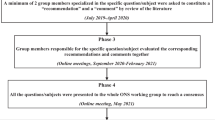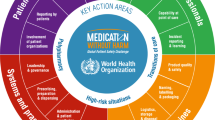Abstract
Background/objectives:
The compounding of personalized parenteral nutrition mixtures (PPNMs) for home parenteral nutrition (HPN) gives the possibility to better satisfy nutritional requirements for patients in selected clinical conditions. The objective of this study was to compare the composition of PPNMs prescribed in selected cases, by a practitioner nutritionist, with that of industrially manufactured standard parenteral nutrition mixtures (SPNMs).
Subjects/methods:
Two hundred and ninety-eight patients (151 men, 147 women, aged 17–87 years) on HPN, followed up in 2011 at our Center, were retrospectively recruited.
Results:
Industrially manufactured SPNMs were prescribed in 230 (77.2%) patients, whereas compounded PPNMs were prescribed in 68 (22.8%). Formulation of PPNMs, adjusted for body weight, did not significantly differ from SPNMs as regards total daily calorie amount, but was significantly different as far as nutrient composition is concerned (P<0.01). Analysis on the daily amount of nutrients per kg of body weight and per patient disease showed that 16/34 (47%) benign chronic intestinal failure (CIF) patients, 47/233 (20%) cancer patients and 5/31 (16%) patients grouped as ‘having other diseases’ needed personalized mixtures (in PPNMs 4–9 nutrients were significantly different from those in SPNMs). Moreover, in CIF patients receiving PPNMs, frequent changes in the formulation (mean 6 times per year, range 1–28) were necessary.
Conclusions:
Our data suggest that, presently, PPNMs cannot be completely replaced by SPNMs owing to special needs in macro and/or micronutrients of some patients and/or the necessity of frequent changes in the nutritional mixture composition, at least until stabilization of clinical and metabolic conditions.
This is a preview of subscription content, access via your institution
Access options
Subscribe to this journal
Receive 12 print issues and online access
$259.00 per year
only $21.58 per issue
Buy this article
- Purchase on Springer Link
- Instant access to full article PDF
Prices may be subject to local taxes which are calculated during checkout
Similar content being viewed by others
References
Ellis BW, Stanbridge RL, Fielding LP, Dudley HA . A rational approach to parenteral nutrition. BMJ 1976; 1: 1388–1391.
American Gastroenterological Association. American Gastroenterological Association medical position statement: parenteral nutrition. Gastroenterology 2001; 121: 966–969.
Staun M, Pironi L, Bozzetti F, Baxter J, Forbes A, Joly F et al. ESPEN Guidelines on Parenteral Nutrition: home parenteral nutrition (HPN) in adult patients. Clin Nutr 2009; 28: 467–479.
De Legge M, Wooley JA, Guenter P, Wright S, Brill J et alAmerican Society for Parenteral and Enteral Nutrition (A.S.P.E.N.). Practice Management Task Force: the state of nutrition support teams and update on current models for providing nutrition support therapy to patients. Nutr Clin Pract 2010; 25: 76–84.
Mascarenhas MR, August DA, DeLegge MH, Gramlich L, Patel V et alAmerican Society for Parenteral and Enteral Nutrition (A.S.P.E.N.). Task Force on Standards for Nutrition Support Physicians. Standards of practice for nutrition support physicians. Nutr Clin Pract 2012; 27: 295–299.
Rollins C, Durfee SM, Holcombe BJ, Kochevar M, Nyffeler MS, Mirtallo J, American Society for Parenteral and Enteral Nutrition (A.S.P.E.N.). Task Force for Revision of Nutrition Support. Standards of practice for nutrition support pharmacists. Nutr Clin Pract 2008; 23: 189–194.
Cano NJM, Aparicio M, Brunori G, Carrero JJ, Cianciaruso B, Fiaccadori E et al. ESPEN Guidelines for adult parenteral nutrition. Clin Nutr 2009; 28: 359–479.
Zanello M, Pironi L, Bobbio Pallavicini F, Candusso M, Dionigi P, Gallitelli L et al. Linee Guida SINPE per la Nutrizione Artificiale Ospedaliera. Riv Ital Nutr Parent Ent 2002; 20: S1–S171.
McMahon MM, Nystrom E, Braunschweig C, Miles J, Compher C, ASPEN. Clinical Guidelines: nutrition support of adult patients with hyperglycemia. JPEN 2012; 20: 1–14.
Silvestri N, Mazzuoli N, Regano N, Silvestri N, Guglielmi FW . The practical utility of guidelines in medicine and artificial nutrition. Nutr Ther Metab 2008; 26: 59–64.
Reeves M, Capra S . Predicting energy requirements in the clinical setting: are current methods evidence based? Nutr Rev 2003; 61: 143–151.
Weijs PJ, Kruizenga HM, van Dijk AE, van der Meij BS, Langius JA, Knol DL et al. Validation of predictive equations for resting energy expenditure in adult outpatients and inpatients. Clin Nutr 2008; 27: 150–157.
Detsky AS, Mclaughlin JR, Abrams HB, L'abbe KA, Whitwell J, Bombardier C et al. Quality of life of patients on long-term total parenteral nutrition at home. J Gen Intern Med 1986; 1: 26–33.
Pironi L, Goulet O, Buchman A, Messing B, Gabe S, Candusso M et al. Outcome on home parenteral nutrition for benign intestinal failure: a review of the literature and benchmarking with the European prospective survey of ESPEN. Clin Nutr 2012; 30: 1–15.
Braga M, Ljungqvist O, Soeters P, Fearon K, Weimann A, Bozzetti F . ESPEN Guidelines on Parenteral Nutrition: surgery. Clin Nutr 2009; 28: 378–386.
Scanzano C, Iacone R, Alfonsi L, Santarpia L, Negro G, Pastore E et al. Home artificial nutrition in a specialized adult clinical nutrition centre: overview 2011. Nutr Ther Metab 2013; 31: 69–76.
Farmacopea Ufficiale Italiana XII ed. Poligrafico dello Stato 2009.
L Fabrizio. Linee guida SIFO. Galenica nutrizionale parenterale: standard tecnici. In: Standard Tecnici delle Farmacie Ospedaliere e dei Servizi Farmaceutici delle Aziende Sanitarie. Il Pensiero Scientifico Editore: Roma, 2006.
Pironi L, Tognoni G . Cost–benefit and cost–effectiveness analysis of home artificial nutrition: reappraisal of available data. Clin Nutr 1995; 14: 87–91.
Santarpia L, Pagano MC, Contaldo F . Home artificial nutrition in Southern Italy: an update four years after the regional regulation. Nutr Ther Metab 2010; 28: 57–63.
Turpin RS, Canada T, Liu FX, Mercaldi CJ, Pontes-Arruda A, Wischmeyer P . Nutrition therapy cost analysis in the US: pre-mixed multi-chamber bag vs compounded parenteral nutrition. Appl Health Econ Health Policy 2011; 9: 281–292.
Mercaldi CJ, Reynolds MW, Turpin RS . Methods to identify and compare parenteral nutrition administered from hospital-compounded and premixed multichamber bags in a retrospective hospital claims database. JPEN 2012; 36: 330–336.
Acknowledgements
All authors participated in the work and contributed to the acquisition of data, its analysis and interpretation, to drafting the article, critically revising it for intellectual content; moreover, they approve and take public responsibility of the version to be published. IR and SC contributed equally to the work and supervised all the different tasks. We thank Mrs Adelaide Soreca for her support in organizing and coordinating the fieldwork in the Home Artificial Nutrition Unit and Dr Maurizio Iervolino together with Dr Gabriella Negro for the valuable laboratory support. Finally, we thank Mrs Laurajean Carbonaro for the English revision of the manuscript.
Author information
Authors and Affiliations
Corresponding authors
Ethics declarations
Competing interests
The authors declare no conflict of interest.
Rights and permissions
About this article
Cite this article
Scanzano, C., Iacone, R., Alfonsi, L. et al. Composition of personalized and standard nutritional mixtures in patients on home parenteral nutrition. Eur J Clin Nutr 68, 433–436 (2014). https://doi.org/10.1038/ejcn.2014.10
Received:
Revised:
Accepted:
Published:
Issue Date:
DOI: https://doi.org/10.1038/ejcn.2014.10



